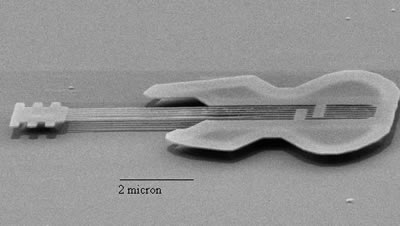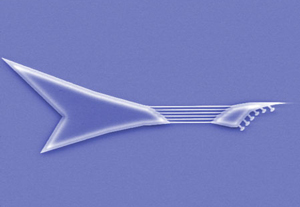Imagine playing the world's smallest guitar, with a laser for your guitar pick. Some nanotechnologists are strumming tiny strings this way – but there's no jamming going on. As this ScienCentral News video reports, they're trying to make much smaller, cheaper electronics that could use less energy.
Playing with Light
The next time a friend is pouring out his sob story to you, you can tell him that the world's tiniest guitar is playing for him. Physicists at Cornell University have created a nanoscale "guitar" about as wide as a single red-blood cell.


This device isn't really a guitar, but since the researchers are building very tiny objects to study vibration and resonance, it's obvious why they're thinking musically. "There tends to be sort of a natural assignment of names that have musical association," saysHarold Craighead, professor of applied and engineering physics and co-director of the Nanobiotechnology Center at Cornell University. "We have little discs that vibrate; sometimes we refer to those as the drums. We've made sets of rods, and when you put those side by side, they tend to look something like a harp, or a xylophone, and so we often refer to these devices as the harp device, or the xylophone device. Even simple shapes often end up having a shape that sort of suggests a musical instrument, and they also vibrate. So when we talk about the vibrations, that, of course is analogous to what goes on in an instrument that has a string or something else that shakes."
The nano "guitar" and its strings are made of silicon, with techniques adapted from those used to make electronic integrated circuits. The team "plays" their guitar in a vacuum chamber, using a laser in place of a guitar pick. When a laser hits a string, the heat makes it vibrate at extremely high frequencies, about 130,000 times—or 17 octaves—higher than a normal guitar. "The so-called strings are free to move, clamped at both ends," says Craighead. "That clamping allows us to shine light on that string, change the temperature, and generate stresses that cause the string to move. The different motions of a single string or different strings moving allow us to do something analogous to playing the guitar." The nano "guitar"'s frequencies are much too high for the human ear to pick up. But the Cornell team can detect the vibrations and electronically scale them down to audible tones. "When we move the light beam around, we can make tones that every once in a while sound sort of appealing," says Craighead.
The goal of the nano "guitar" and other tiny "instruments" isn't to make music, but rather to use very small devices that vibrate at very high frequencies to find ways to create cheaper electronics that save energy. "One of our major advances has been to learn how to use light beams to cause things to vibrate," says Craighead. "This is an alternative to using lots and lots of little wires to interact with things. We can use light beams that scan over the surface and start things in motion and detect what goes on. We're trying to figure out what sort of new possibilities are allowed by this optical method of interacting with mechanical devices."
As a start, the Cornell team, that includes the research groups of Craighead andJeevak Parpia, professor of physics, uses the laser light to measure the motion it creates. All the "instruments," Craighead explains, have some parts that can move and some that are clamped down to a surface. "We need the light to bounce off the underlying surface and the moveable part simultaneously in order to make things move," he says. "The exact ways in which parts are clamped to the surface are critical for the motion."
Nano-objects that can vibrate at a higher frequency than the guitar—radio frequencies up to hundreds of megahertz—could substitute for other components in electronic circuits. Tiny vibrating nanorods could replace the oscillating quartz crystals used in cell phones and other wireless devices, taking up little space and drawing only tiny amounts of power.
The tiny instruments also could sense very small forces in machinery, to detect or even predict problems. But more research needs to be done. "When things get small, their mechanical properties may change," says Craighead. "They could get either stronger or weaker or stiffer or softer. So we have to figure out how the materials work before we can figure out how we can design things. Then we may be able to design things for completely different uses."
This research was presented in November, 2003 at the American Vacuum Society. It is part of the Cornell Center for Materials Research Nanomechanics research activity supported by the National Science Foundation.

Feature
The nano "guitar" and its strings are made of silicon, with techniques adapted from those used to make electronic integrated circuits. The team "plays" their guitar in a vacuum chamber, using a laser in place of a guitar pick. When a laser hits a string, the heat makes it vibrate at extremely high frequencies, about 130,000 times—or 17 octaves—higher than a normal guitar. "The so-called strings are free to move, clamped at both ends," says Craighead. "That clamping allows us to shine light on that string, change the temperature, and generate stresses that cause the string to move. The different motions of a single string or different strings moving allow us to do something analogous to playing the guitar." The nano "guitar"'s frequencies are much too high for the human ear to pick up. But the Cornell team can detect the vibrations and electronically scale them down to audible tones. "When we move the light beam around, we can make tones that every once in a while sound sort of appealing," says Craighead.
 |
| A nano "xylophone" image: Lidija Sekaric |
As a start, the Cornell team, that includes the research groups of Craighead andJeevak Parpia, professor of physics, uses the laser light to measure the motion it creates. All the "instruments," Craighead explains, have some parts that can move and some that are clamped down to a surface. "We need the light to bounce off the underlying surface and the moveable part simultaneously in order to make things move," he says. "The exact ways in which parts are clamped to the surface are critical for the motion."
Nano-objects that can vibrate at a higher frequency than the guitar—radio frequencies up to hundreds of megahertz—could substitute for other components in electronic circuits. Tiny vibrating nanorods could replace the oscillating quartz crystals used in cell phones and other wireless devices, taking up little space and drawing only tiny amounts of power.
The tiny instruments also could sense very small forces in machinery, to detect or even predict problems. But more research needs to be done. "When things get small, their mechanical properties may change," says Craighead. "They could get either stronger or weaker or stiffer or softer. So we have to figure out how the materials work before we can figure out how we can design things. Then we may be able to design things for completely different uses."
This research was presented in November, 2003 at the American Vacuum Society. It is part of the Cornell Center for Materials Research Nanomechanics research activity supported by the National Science Foundation.

Feature

No comments:
Post a Comment